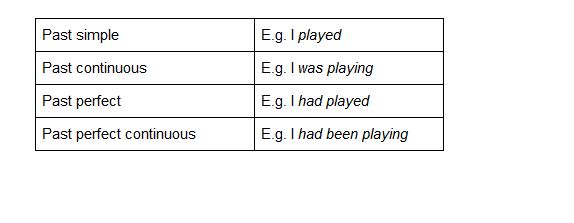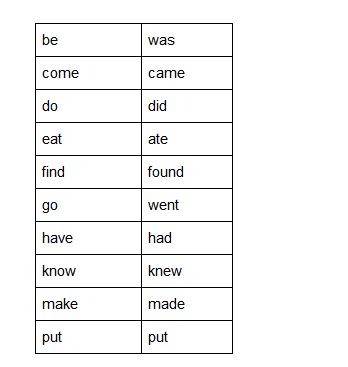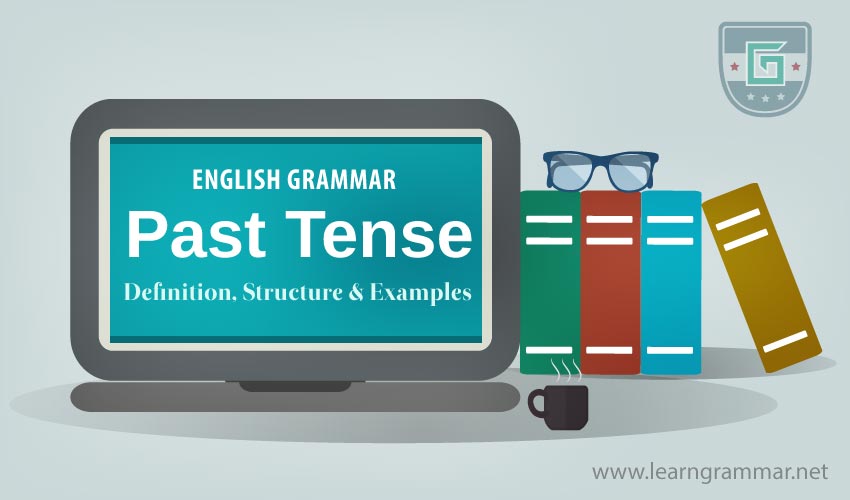The past tense is one of the three main verb forms in the English language, alongside the present tense and the future tense. This explanation will introduce the past tense, explain the different uses of the past tense, and provide plenty of examples.
What is the past tense?
In English grammar, the past tense is a verb tense used to describe an action or event that occurred in the past.
The main functions of the past tense are:
- to express that an action/state of being happened in the past (e.g. Ava went to the farm)
- to talk about repeated and habitual actions/events in the past (e.g. we used to go to Wales all the time)
- to refer to the present (e.g. It’s time I went to work)
- to refer to the future (e.g. Imagine if we moved to Italy)
We can also use the past tense for wishes and hypotheses ( e.g. I wish I had a car, What if you fell?) or to be polite (e.g. I was wondering if you could send me the file).
Now we have a basic understanding of why we use the past tense, let’s explore it in more detail. We will learn about the different types of past tense and look at plenty of examples along the way!
Examples of past tense
Here are some examples of the past tense in context:
- I climbed up the huge mountain.
- They went to the shop.
- I watched TV all day.
- She was working all day on Saturday.
- They hadn’t been to school for a while.
- He was laughing loudly.

Types of past tense
Let’s explore the different types of past tense a little further.
Each of the three main tenses (past, present, and future) is divided into four aspects. An aspect is a verb form concerned with time and indicates an action’s completion, duration, or repetition. Aspects work alongside tenses to show the duration of an action within a particular tense.
The four aspects are: simple, continuous (sometimes called ‘progressive’), perfect, and perfect continuous (progressive). Therefore, the types of past tense are also simple, continuous, perfect, and perfect continuous.
-
The simple aspect is used to express facts.
-
The continuous aspect shows that an action is ongoing and yet to be completed.
-
The perfect aspect is used for actions that started in the past but have some connection to the present.
-
The perfect continuous aspect is a combination of the continuous aspect and the perfect aspect. It is used to show that an action has/had/or will have been in progress since a specific point in time.
Now that we have a good idea of how tenses and aspects work together, let’s look at the four different types of past tense.
Using the past simple tense
The past (simple) tense is the most common past form in the English language. It is used to talk about a completed action or event that started and ended in the past. In other words, the past simple tense describes a completed action in the past (e.g. He went to school yesterday).
The past simple tense can also be used to refer to a habitual or repeated action/event that occurred regularly (e.g. I used to go to London every Christmas).
You can form the past simple tense by using this formula:
Subject + past tense verb
For regular verbs, we form the past simple (Verb form 2) by adding the inflection -d or -ed to the verb’s root. E.g. I dance → I danced
Take a look at these examples:
- She often travelled to Spain.
- We danced all night long.
- I never wanted to see him again.
Notice how each of these examples contains a finished action/event that took place in the past (e.g. travelled, danced). We may also reference the specific point of time/frequency of the verb (e.g. often, all night long).
Things are a bit more tricky with irregular verbs such as ‘run → ran’ and ‘be → was/were/been’ which don’t follow the same inflection rule. Unfortunately, we just have to memorise the spellings for these irregular verbs. Here are some more examples of irregular past tense verbs.
- We saw the monkeys at the zoo.
- They were angry.
- I swam 6 miles in the race.
- The rooster rose early every morning
Other ways to form the past simple tense include the following:
| Negatives |
| Subject + did not (didn’t) + verb root (the infinitive without ‘to’) E.g. I didn’t wear my new jacket. |
| Interrogative |
| Did + subject + verb root (the infinitive without ‘to’) E.g. Did she see the monkeys? |
Past continuous (progressive) tense
The past continuous tense (also known as the past progressive) is used to describe an ongoing action or event in the past.
The past continuous (progressive) tense is formed like this:
subject + was/were + verb root + -ing
- I was talking to him the other day
- The sun was shining
- They were practising the guitar
The past continuous can be used to ‘set the scene’ for another event and is often used to describe an action that was interrupted by another action. Like this:
-
He was walking down the road when the dog jumped out.
-
We were all having lunch when it started to rain.
Both examples show an ongoing past action (walking/having lunch) interrupted by another past action (dog jumped out/started to rain).
Notice how the sentences contain the past form of ‘to be’ (was/were) as well as the verb ending with ‘-ing‘. This helps us recognise that the past progressive (continuous) is being used.
Other ways to form the past progressive (continuous) include the following:
| Negatives |
| Subject + was/were not + verb root + -ing E.g. Ella was not sleeping |
| Interrogative |
| Were/was + subject + verb root + -ing E.g. Was Chloe singing last night? |

Past perfect tense
The past perfect tense is used to talk about an action/event that was completed in the past, often before another action/event took place.
You can use this formula to make the past perfect tense:
Subject + had + past participle
- I had slept all day.
- Amy hadn’t taken a day off for months.
- He had just gone home.
Notice how each sentence uses the past participle verb form (or verb type 3). In the example sentences, the part participle verbs are slept, taken, and gone. We always use past participles when forming perfect tenses.
We often use the past perfect to talk about an action/event that was completed before a second action/event occurred. Take a look at these examples:
-
They had left by the time the bus arrived.
-
After Sarah had finished school, she went for dinner
Notice how each example includes two actions/events which are both in the past, one after the other.
Other ways of forming the past perfect include the following:
| Negatives |
| Subject + had not + past participle E.g. Emma hadn’t slept |
| Interrogative |
| Had + subject + past participle E.g. Had you studied? |
Past perfect continuous (progressive) tense
The past perfect continuous (progressive) tense describes an action that started in the past and continued into another time in the past.
A past perfect progressive sentence is formed by using the auxiliary verbs had and been together with the main verb + -ing (e.g.walking). For example, ‘I had been walking’.
We can form the past perfect progressive (continuous) tense by using this formula:
subject + had been + verb root + -ing
Check out these examples:
- Daniel had been cooking dinner all afternoon.
- I had been reading a really interesting book.
Like the past perfect, the past perfect progressive can also be used to ‘set the scene’ for another past action.
- We had been driving for an hour before the car broke down.
- Faye had been cleaning the house when I came back.
- I had been showing them a video before you arrived.
Other ways to form the past perfect continuous (progressive) tense include:
| Negatives |
| Had not (hadn’t) + been + verb root + -ing E.g. John had not been eating |
| Interrogative |
| Had + subject + been + verb root + -ing E.g. Had she been running? |
Past tense revision sheet
| Tense | Explanation | Examples of use |
| Past simple | The past simple tense is used to talk about a completed action or event that started in the past and ended in the past. |
|
| Past continuous | Past continuous tense (also known as past progressive tense) is used to express that an action or event was ongoing in the past. |
|
| Past Perfect | The past perfect tense expresses a completed action in the past, often before another action/event took place. |
|
| Past Perfect Continuous | The past perfect continuous expresses that an action started in the past and continued into another time in the past. |
|
Using the past tense to refer to the present or future
It may sound unlikely, but the past tense can be used to refer to the present or future in particular situations. Some examples of these situations include:
-
To express urgency — e.g. The train is here soon. It’s time we left.
-
To talk about plans — e.g. I was thinking of booking a flight to Barbados for my birthday’. Here, the past continuous expresses uncertainty about plans (although it sounds like a good plan to us!).
-
To be polite — e.g. I was wondering if you could send me the documents or I was hoping that you’d come this weekend. Here, the past continuous sounds more polite than the simple present ‘I hope you come this weekend’ as it is less direct.
-
To express possibility/wishes/hypothesise — e.g. Suppose someone called me tomorrow, I wish I had a bigger TV or What if you missed the train?
Past Tense — Key takeaways
-
The past tense is one of the three main tenses in the English language.
-
There are four aspects of the past tense: past (simple), past progressive (continuous), past perfect, and past perfect progressive (continuous).
-
The main functions of the past tense are: to express that an action/state of being has happened in the past, to talk about repeated habitual actions/events in the past, to refer to the present tense, or to refer to the future tense.
-
To turn a regular verb into a past tense verb, we add the inflection ‘-d/-ed’
Verbs are words which tell us the time of action in a sentence happened. The time that a verb shows is called tense.
| Present | Past | Past Participle |
| arise | arose | arisen |
| awake | awoke (or awaked) | awaked (or awoken) |
| bear (to give birth) | bore | born |
| beat | beat | beaten (or beat) |
| become | became | become |
| begin | began | begun |
| bet | bet | bet |
| bind | bound | bound |
| bite | bit | bitten |
| bleed | bled | bled |
| blow | blew | blown |
| break | broke | broken |
| breed | bred | bred |
| bring | brought | brought |
| burst | burst | burst |
| buy | bought | bought |
| cast | cast | cast |
| catch | caught | caught |
| choose | chose | chosen |
| come | came | come |
| cut | cut | cut |
| deal | dealt | dealt |
| dig | dug | dug |
| dive | dived (or dove) | dived |
| do | did | done |
| draw | drew | drawn |
| dream | dreamed (or dreamt) | dreamed (or dreamt) |
| drink | drank | drunk |
| drive | drove | driven |
| eat | ate | eaten |
| fall | fell | fallen |
| feed | fed | fed |
| feel | felt | felt |
| fight | fought | fought |
| find | found | found |
| flee | fled | fled |
| fly | flew | flown |
| forget | forgot | forgotten |
| forgive | forgave | forgiven |
| freeze | froze | frozen |
| get | got | got (or gotten) |
| give | gave | given |
| go | went | gone |
| grind | ground | ground |
| grow | grew | grown |
| hang (to execute) | hanged | hanged |
| have | had | had |
| hear | heard | heard |
| hide | hid | hidden |
| hit | hit | hit |
| hold | held | held |
| hurt | hurt | hurt |
| keep | kept | kept |
| know | knew | known |
| lay | laid | laid |
| lead | led | led |
| leave | left | left |
| lend | lent | lent |
| let | let | let |
| lie | lay | lain |
| light | lighted (or lit) | lighted (or lit) |
| lose | lost | lost |
| make | made | made |
| mean | meant | meant |
| meet | met | met |
| mistake | mistook | mistaken |
| pay | paid | paid |
| prove | proved | proved (or proven) |
| put | put | put |
| quit | quit | quit |
| read | read | read |
| ride | rode | ridden |
| ring | rang | rung |
| rise | rose | risen |
| run | ran | run |
| say | said | said |
| see | saw | seen |
| sell | sold | sold |
| send | sent | sent |
| set | set | set |
| shake | shook | shaken |
| shed | shed | shed |
| shoot | shot | shot |
| shut | shut | shut |
| sing | sang | sung |
| sink | sank | sunk |
| sit | sat | sat |
| slay | slew | slain |
| sleep | slept | slept |
| slide | slid | slide |
| sling | slung | slung |
| slink | slunk | slunk |
| speak | spoke | spoken |
| spend | spent | spent |
| spin | spun | spun |
| spit | spit (or spat) | spit (or spat) |
| split | split | split |
| spread | spread | spread |
| spring | sprang (or sprung) | sprung |
| stand | stood | stood |
| steal | stole | stolen |
| stick | stuck | stuck |
| stink | stank (or stunk) | stunk |
| stride | strode | stridden |
| strike | struck | struck |
| string | strung | strung |
| strive | strove (or strived) | striven (or strived) |
| swear | swore | sworn |
| sweep | swept | swept |
| swell | swelled | swelled (or swollen) |
| swim | swam | swum |
| swing | swung | swung |
| take | took | taken |
| teach | taught | taught |
| tear | tore | torn |
| tell | told | told |
| think | thought | thought |
| thrive | throve (or thrived) | throve (or thriven) |
| throw | threw | thrown |
| thrust | thrust | thrust |
| wake | woke (or waked) | waked (or woken) |
| win | won | won |
| wind | wound | wound |
| wring | wring | wrung |
| write | wrote | written |
Verb forms of Verb To be
| Present tense | Past tense | Future tense |
| is/ am/ are | was/ were | will/shall |
Now let’s use the words from the above list and understand how different forms of verbs are formed using the root word.
- We usually make the past tense by adding “d” or “ed” to the verb root word. Some verbs have irregular past tenses. We do not add “d” or “ed” to the irregular past tense verb, but change the spelling. grow becomes grew not growed.
- We make the present tense by using the verb root word or the verb “to be”, am and an “ing” word eg: walk -> walking.
- We make the future tense by using the verb “to be” and the verb root word. Will / Shall is the verb “to be”.
| Root word | Past tense | Present tense | Future tense |
| Walk | I walked. | I walk. | I will walk. |
| Help | I helped. | I help. | I will help. |
| Learn | I learned. | I learn. | I will learn. |
| Write | I wrote | I write | I shall write |
| grow | It grew | It grows | It will grow |
Keep exploring EnglishBix for quality resources on three forms of verbs and learn how they are used.
Do you have difficulty with the past tenses in English? Do you know the difference between the past simple and past perfect? Knowing what they are and when to use them can be tricky, but don’t worry we are here to help you with all your past tense doubts!
We’ll show you when to use them and give you some fun ways to practise them at home!
So, let’s start by looking at the four main past tense forms in English and their most common uses.
1. Past Simple
The first past tense you’ll often learn in your English classes is the past simple.
Form
For regular verbs we add -ed to the infinitive form of the verb. E.g.
Irregular verbs however, take a different form. There are hundreds of irregular verbs and you just have to learn them off by heart! Here are some of the most common:
Use
The main use of the past simple is for finished actions in the past. For example:
- I was born in San Francisco.
- I cleaned my room.
- I forgot my key.
We can use it with a finished time phrase like in the sentences below:
- Yesterday I went to the supermarket.
- Last night we watched the football.
- The phone rang five minutes ago.
Other common time expressions you can use are:
last month, last week, last summer, in 1997, when I was a child, a long time ago, on Monday, in February etc.
We also use the past simple for the main action when telling a story.
E.g. I woke up on my wedding day, I jumped out of bed and immediately called my brother. He didn’t pick up and so I began to worry.
Let’s see how much you’ve learned!
Activity One
We are going to test your knowledge of regular and irregular verbs! Watch this cartoon of Mr Bean making spaghetti. Then have a go at conjugating the verbs below into the past simple. Finally put the sequence in order they appear in the video!
Mr. Bean:
________ (brush) his teeth
________ (try) to cook spaghetti in the pot
________ (put) the spaghetti in the bath
________ (kill) the bird
________ (take) the spaghetti out of the cupboard.
*Check your answers at the end of this post.
2. Past Continuous
Another common past tense is the past continuous.
Form
We form it using was/were + verb + ing.
Use
A common use of the past continuous is to show that a longer action was interrupted (usually by a shorter action in the past simple). We often use the time expression when. For example:
- I was swimming in the sea when I saw a shark.
- Henry was sitting at home when the phone rang.
- She was playing golf when it began to rain.
When two continuous actions are happening at the same time we use the time expression while.
- I was talking to Sarah while she was driving.
- We were playing while dad was cooking dinner.
We can also use it to show a continuous action happening at a specific time in the past.
- Yesterday morning I was practising the piano.
- At 6 o’clock I was eating dinner.
- What were you doing at 8pm last night?
Finally, it can be used to add some description to a story.
E.g. It was a beautiful day. The sun was shining and the birds were singing. We were walking around our favourite park.
Note we don’t usually use continuous tenses with stative verbs.
Now let’s practise!
Activity Two
Look at these pictures and complete the sentences with your own ideas!
At 8 o’clock last night I was…
It was a Wednesday afternoon…
*Check your answers at the end of this post
3. Past Perfect
Now we can move on to a slightly more difficult tense – the past perfect.
Form
We make the past perfect by using had + past participle.
Use
We use it when one action happens before another past action. For example:
A. The film had started when we arrived. (the film started before we arrived)
B. The film started when we arrived (we arrived at the same time the film started)
We use time expressions such as before, by the time and when.
Be careful lots of students overuse the past perfect! Remember you only use it for actions that happened before the main action.
Activity Three
Learn more about the past perfect with this grammar game show from BBC Learning English.
How many answers did you get correct?
&nhbsp;
4. Past Perfect Continuous
The past perfect continuous is very similar to the past perfect.
Form
We form the past perfect continuous with had + been + verb + ing.
Use
We use it to show that an action which started in the past continued up to another point in the past. For example:
- She had been living in Italy for three years when she lost her job.
- I had been waiting for ten minutes before the bus came.
- By the time Steve arrived I had been working for nearly eight hours!
With the past perfect we use time expressions such as for five hours, for 2 weeks, for a long time, by the time.
We can also use it to talk about the cause of something in the past. E.g.
- Susan was sweating because she had been running.
- Henry was late because he had been studying.
Note we don’t usually use continuous tenses with stative verbs.
Activity Four
Practise when to use past perfect vs. past perfect continuous with this quiz!
Choose the correct answer in each question:
1. The children were tired because they had played all morning / had been playing all morning.
2. The customers were angry because the waiter had forgotten / had been forgetting their order.
3. He had married / had been marrying her two years before we met.
4. I had never stayed / had never been staying in London until 2012.
5. We had tried / had been trying the door for several hours before Anna found her key.
*Check your answers at the end of this post.
Activity Five
Finally, put all your new knowledge to the test! Look at this photo and answer the questions below using the different past tenses. Leave us a comment below with your ideas!
Speculate
1. Where was this photo taken?
2. Why was the man looking at the people in the background when the photo was taken?
3. What had happened just before the photo was taken?
4. Where had the man been going before the photo was taken?
*Check your answers at the end of this post.
—
Did you enjoy this blog? Had you studied all these rules before reading it? Leave us a comment and let us know!
You may also like to read our article about common grammar mistakes in English.
*Answers
Activity One:
E) He took the spaghetti out of the cupboard.
B) He tried to cook spaghetti in the pot.
C) He put the spaghetti in the bath.
A) He brushed his teeth.
D) He killed the bird.
—
Activity Two (example sentences):
At 8 o’clock last night I was watching TV.
At 8 o’clock last night I was reading a book.
At 8 o’clock last night I was cooking my dinner.
It was a Wednesday afternoon, it was raining heavily, I was sitting on the bus trying not to fall asleep.
—
Activity Four:
had been playing.
had forgotten.
had married.
had never stayed.
had been trying.
—
Activity Five (example sentences):
The photo was taken in a hotel.
The man was looking at the people in the background because he thought he recognised one of the women.
Just before the photo was taken the man had gone to the kitchen to get a drink of water.
The man had been walking back to his room before the photo was taken.
Glossary for Language Learners
Find the following words in the article and then write down any new ones you didn’t know.
Tricky (adj):: difficult.
Off by heart (exp): from memory.
To conjugate (v): to add different endings to a verb in order to produce all its different forms.
To move on (pv): to transition to something new.
Overuse (v): to use something too much.
Game show (n): a television programme where contestants win prizes.
Speculate (v): to guess possible answers to a question when you do not have enough information to be certain.
Key
adj = adjective
pv = phrasal verb
v = verb
n = noun
exp = expression
Study English at Oxford House Barcelona
Interested in taking an English course at Oxford House Barcelona? Check all the different English classes we can offer you, or our summer courses, and contact us for more information.
Study English at Oxford House Barcelona
Interested in taking an English course at Oxford House Barcelona? Check all the different English classes we can offer you, or our summer courses, and contact us for more information.
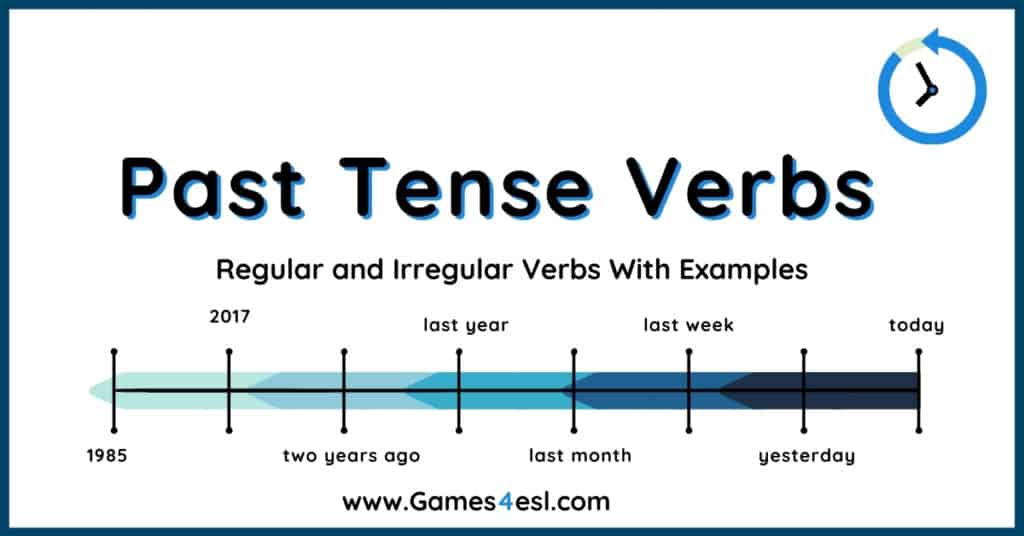
Learning many different past tense verbs is essential for English language learners if they are to talk about the past in English. Learning the past tense can, however, be quite challenging for students because there are regular and irregular past tense verbs and different rules for changing a verb into the past tense.
On this vocabulary page, you can find a list of regular and irregular past tense verbs with example sentences. We will also explain the simple past tense rules and how to make regular verbs into the past tense. And, check out the bottom of the page for related resources for learning and teaching about the past tense.
With regular verbs, there are certain rules to follow to change the verb into the past tense. Below we will explain these rules and provide examples of regular past tense verbs with example sentences.
Past Tense Rule 1 | Add -ed
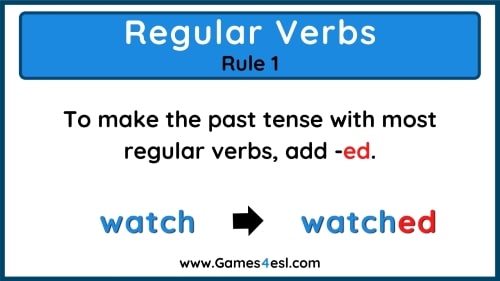
With most regular verbs, to make the past tense we simply add -ed to the end of the verb. Here are some examples of common past tense verbs that end in –ed.
- watch – watched – I watched a movie yesterday.
- play – played – Chris played soccer with his friends before school.
- talk – talked – We talked on the phone for hours last night.
- start – started – Kelly started to dance when she heard the music.
- cook – cooked – Mum cooked a delicious meal for lunch.
- walk – walked – I walked to work today.
- show – showed – I showed my ticket to get on the train.
- rain – rained – It rained all morning.
- learn – learned – I learned a lot at school today.
- clean – cleaned – I cleaned my room before going to sleep.
- wash – washed – Dad washed the dishes after dinner.
- wait – waited – I waited at the bus stop for 30 minutes.
- want – wanted – I wanted to see a movie but the tickets were sold out.
- need – needed – Matt needed to drink some water after his workout.
- end – ended – The movie ended before I even arrived.
Past Tense Rule 2 | Add -d
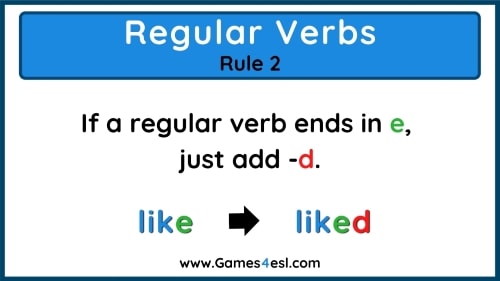
If a regular verb ends in the letter ‘e’, then to make the past tense, simply add –d. Here are some examples of common past tense verbs that end in –d.
- like – liked – I liked your performance today. It was really good.
- close – closed – I closed my eyes and immediately fell asleep.
- smile – smiled – Kelly smiled at me and I smiled back.
- type – typed – Chris typed his essay on his computer.
- race – raced – I raced here as fast as I could.
- care – cared – Sally cared for her sick puppy yesterday.
- bake – baked – Mom baked cookies. They smell delicious.
- escape – escaped – 5 people escaped from prison today.
Past Tense Rule 3 | Add -ied
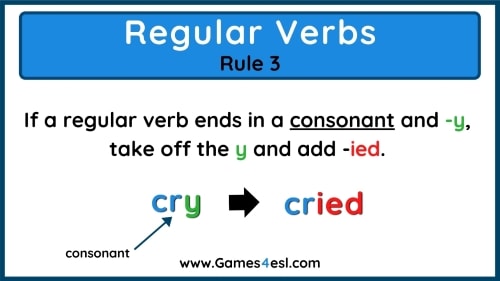
If a verb ends in a consonant followed by the letter ‘y’, then to change into a past tense verb, take off the ‘y‘ and add –ied. For example, the word ‘cry’ ends in a consonant (r) followed by ‘y’. So, cry becomes cried.
Here are some examples of common past tense verbs that end in y.
- cry – cried – I cried after reading the book. It was such a sad story.
- fry – fried – For breakfast, I fried some eggs.
- try – tried – Chris tried to win the race.
- carry – carried – Kelly’s boyfriend carried the shopping bags for her.
- study – studied – I studied all night for the test.
- marry – married – My parents got married in 1975.
- worry – worried – I worried all day about the results of the test.
Past Tense Rule 4 | Double The Consonant And Add -ed
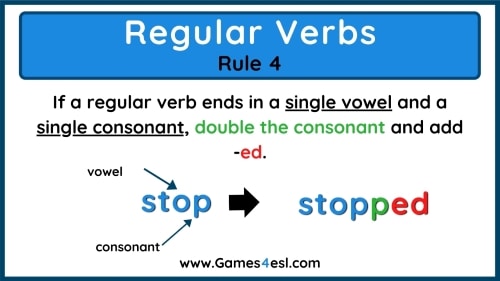
If a regular verb ends in a single vowel followed by a single consonant, then double the consonant and add –ed. This is the rule, except for words ending in the letter ‘x’.
Here are some examples of common past tense verbs which follow this rule.
- stop – stopped – The baby stopped crying when his mom picked him up.
- plan – planned – The teacher planned a fun lesson.
- hop – hopped – The rabbit hopped away when it saw me.
- clap – clapped – The audience clapped loudly at the end of the concert.
- jog – jogged – I jogged for 5 miles yesterday.
- beg – begged – The boy begged his teacher not to call his mom.
- fan – fanned – I fanned my face with a newspaper as it was so hot.
- rip – ripped – Chris ripped his jeans when bent over to pick something up.
- zip – zipped – I zipped up my jacket as it was cold.
Irregular Past Tense Verbs List
Unlike regular past tense verbs, irregular past tense verbs don’t follow any easy to remember rules. And so, students simply need to memorize irregular past tense verbs.
Here is a list of common irregular past tense verbs with example sentences.
- go – went – I went to the zoo yesterday.
- see – saw – I saw an elephant at the zoo.
- come – came – Mom came home at 11 o’clock.
- read – read – I read an interesting book last night.
- write – wrote – Kelly wrote a letter to Chris.
- meet – met – I met my friends for lunch today.
- eat – ate – We ate spaghetti and pizza.
- buy – bought – I bought a new jacket last weekend.
- is – was – Yesterday, the weather was terrible.
- make – made – Chris made a robot at school today.
- sleep – slept – I slept until midday.
- wear – wore – I wore my new jacket to school today.
- win – won – England won the 1966 World Cup.
- bring – brought – I brought sandwiches for lunch.
- catch – caught – Yesterday, my father and I caught a lot of fish.
- choose – chose – I chose this dress. What do you think?
- cut – cut – I cut my finger when I was cooking yesterday.
- dig – dug – The dog dug a big hole in the garden.
- draw – drew – Kelly drew a picture of the dog.
- drink – drank – The teacher drank 2 cups of coffee this morning.
- drive – drove – We drove all night to get here.
- fall – fell – I fell down yesterday, but I am okay.
- fight – fought – My great grandfather fought in World War 2.
- fly – flew – I flew here from Canada.
- find – found – I found this wallet. Is it yours?
- get – got – Chris got a new watch for his birthday.
- give – gave – Kelly gave Chris a new watch for his birthday.
- hear – heard – I heard that it’s your birthday today. Happy birthday.
- hide – hid – We hid behind the sofa to surprise Chris on his birthday.
- know – knew – Chris knew about the surprise party.
- lose – lost – I lost my wallet. Have you seen it?
- pay – paid – I paid a lot of money for this dress.
- ride – rode – We rode our bikes in the park at the weekend.
- run – ran – The dog just ran across the road.
- say – said – The doctor said you should get some rest.
- sing – sang – The choir sang beautifully.
- sit – sat – The students all sat down in their seats.
- speak – spoke – I spoke to my grandma last week.
- take – took – I took a shower at 8 am.
- think – thought – Chris thought the test was on Monday.
- wake – woke – I woke up at 7:30.
- break – broke – Yesterday, I fell over and broke my glasses.
Resources To Teach The Past Tense
Here are some free resources you can use to teach past tense verbs in English.
- Past Tense Regular Verbs PowerPoint
- Past Tense Irregular Verbs PowerPoint
- Past Tense Worksheets
- Past Tense Lesson Plan
- Past Tense Game
- Online Past Tense Quiz
/ English Grammar / Past Tense: Definition, Structure & Examples
Past Tense: Definition, Structure & Examples
Past tense also has four forms.
- Past Indefinite Tense
- Past Progressive (Continuous) Tense
- Past Perfect Tense
- Past Perfect Progressive Tense
Past Indefinite Tense
The past indefinite tense, also known as simple past tense, is used to indicate a finished or completed action/task that occurred/happened at a specific point in time in the past. ‘A specific time’ can be diverse and can cover a long period of time but it cannot be undeterminable.
Structure:
Subject + verb in the past form + . . . . . + adverb of time + . . . . .
Note: Adverb of time can also be at the beginning of the sentence. Other sentences can also refer to that adverb and can use simple past tense.
Example:
- Alex went to Mexico last year.
- I ate a mango a few minutes ago.
- He had an exam yesterday.
- I used to travel around the world when I was fit. (It can also indicate a habit of the past which is not a habit in the present.)
More: Past Indefinite Tense Examples.
Past Progressive (Continuous) Tense
The past progressive tense is used to demonstrate an action that was happening in the past for a period of time in a particular context. The context can be a specific time or another action.
Structures:
|
Subject + was/were + verb + ing + . . . . . a specific time |
|
Alex was sleeping yesterday at 6.30 AM I was cleaning the dishes at around 5.30-6.30 yesterday. |
|
When + subject + simple past tense + subject + was/were + verb+ing . . . . |
|
When I went out, you were shouting from behind. When Alex came, I was sleeping. |
|
Subject + was/were + verb+ing + when + subject + simple past tense . . . . |
|
You were shouting from behind when I went outside. I was sleeping when Alex came home. |
|
While + subject + was/were + verb+ing + subject + was/were + verb+ing . . . . |
|
While I was sleeping, you were making noises. While Alex was playing, I was sleeping. |
Note: While can also be placed between the two clauses, and one of the clauses can be of simple past tense.
More Examples of Past Continuous Tense Examples.
Past Perfect Tense
The past perfect is used to demonstrate an action that occurred before another action in the past. There are usually two completed actions in the sentence; one happens before the other.
Structures:
Subject + had + past participle form of the main verb + before + subject + simple past tense . . . .
Alex had completed the task before the teacher asked.
I had bought a phone before you came here.
Before + subject + simple past tense + subject + had + past participle form of the verb +. . . .
Before I went to the office, I finished some business with her.
Before she went home, she had taken a test.
Subject + simple past tense + after + subject + had + past participle . . . .
Mark ate after I had bought him a bat.
I went to the office after I had finished some business with her.
After + subject + had + past participle + subject + simple past tense . . . .
After I had bought a phone, she came to the shop.
After she had gone, I came in.
Note: When can be used in place of before or after in any of the above structures.
More examples of Past Perfect Tense Examples.
Past Perfect Progressive Tense
The past perfect progressive tense is an extension to the past perfect tense and its structures. Past perfect progressive is used to demonstrate an action which continued for a specific period of time but stopped before another action.
Structure:
Subject + had + been + verb+ing + . . . . . + for/since + . . . . .+ before + subject + past simple tense
Alan had been playing cricket for 18 years before he retired.
Jack had been living in Sydney since 2010 before he moved to Melbourne.
Note: This tense can be replaced by the past perfect tense withdrawing for/since.
More Examples of Past Perfect Continuous Tense Examples.

